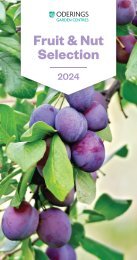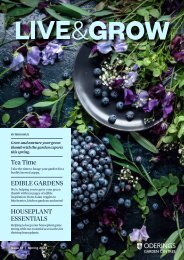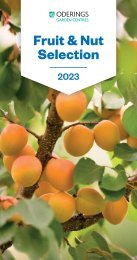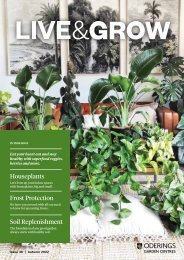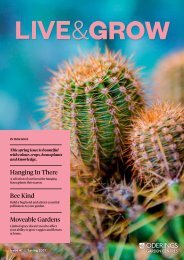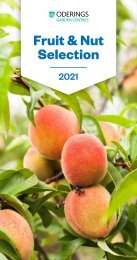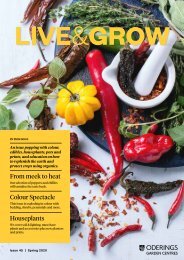Live & Grow Issue 50
Hot topics for gardeners and houseplant enthusiasts. Find out what plants, products and growing methods are best right now.
Hot topics for gardeners and houseplant enthusiasts. Find out what plants, products and growing methods are best right now.
You also want an ePaper? Increase the reach of your titles
YUMPU automatically turns print PDFs into web optimized ePapers that Google loves.
<strong>Grow</strong>ing Garlic<br />
<strong>Grow</strong>ing garlic is easy, and with some<br />
know-how, this can become one of<br />
the many successful crops you can<br />
grow this season. There are different<br />
types of garlic, but the most common<br />
in New Zealand is Printanor Garlic.<br />
Elephant Garlic is an excellent option if<br />
you do not like your garlic too strong,<br />
as it has a milder flavour.<br />
Traditionally garlic is planted on the<br />
shortest day and harvested on the<br />
longest; (plant late May to August and<br />
harvest mid-January to late February).<br />
By planting earlier and harvesting a<br />
little later, your corms will become<br />
larger. The best time to buy garlic is<br />
April/May to ensure you do not miss<br />
out.<br />
Separate and plant each clove of<br />
garlic 2-4cm below the soil surface<br />
and about 10cm apart, ensuring the<br />
pointed end is facing upwards. Use<br />
the bigger cloves to assist with larger<br />
bulbs. The smaller cloves will need<br />
more care to grow, e.g. water and<br />
nutrients. Keeping the growing area<br />
weed free and well-watered during<br />
the summer is essential.<br />
To get the most out of your crop,<br />
you need to incorporate the correct<br />
nutrients at planting time.<br />
Incorporate plenty of compost into<br />
the soil, as well as bone flour and/or<br />
blood & bone to boost calcium and<br />
phosphorus, which is specifically good<br />
for any bulb or root crop. Dig compost<br />
and bone flour/blood & bone into the<br />
root zone when planting, adding 1–2<br />
teaspoons of the bone flour per clove.<br />
Use only New Zealand-grown garlic<br />
from your garden centre for the best<br />
results.<br />
If space is tight, garlic can also be<br />
grown in containers or planter bags,<br />
but it must have good drainage<br />
wherever you grow them.<br />
Once the tips of the leaves begin to<br />
yellow, and the base of the stem goes<br />
soft, it's time to harvest. Make sure<br />
you dig up the garlic; do not rip it from<br />
the ground. If you lift garlic too early,<br />
you will have smaller cloves, whereas<br />
if they are left too long, they will burst.<br />
Once you have dug up your garlic,<br />
gently brush off any soil clinging to<br />
the bulbs, being careful not to gouge<br />
them. Allow three to four weeks of<br />
drying in a well-ventilated and dry<br />
area out of direct sunlight. When the<br />
tops and roots have dried, cut them<br />
off, again being careful not to damage<br />
the bulbs.<br />
Seed Potato & Produce Suppliers<br />
14




